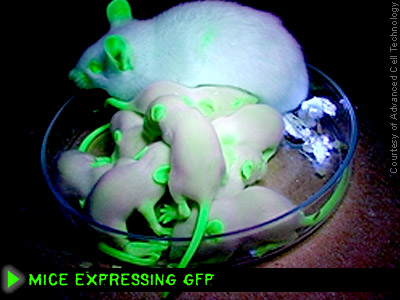Everyday the world becomes stranger and more beautiful. Some enterprising young minds in Korea have genetically modified and cloned some glow in the dark cats. In the picture below the orange cat on the left is glowing orange under an ultra violet light source, whereas a normal cat (right) is merely reflecting green.
 Transcats walk amongst us, as apparently do Transmice.
Transcats walk amongst us, as apparently do Transmice.

The mouse picture is actually from a Forbes article from back in ’01. Which shows just how long this technology has been around. In China and other areas you can already buy genetically modified glowing pets, and hopefully we will have glowing kitties in the rest of the world soon.
Medical and amusement purposes aside, another interesting ramification of this technology is that nothing can ever truly go “extinct” now. One day, when our race is old and wise, this planet can once again team with all of the strange strains of life that, in our youthful ignorance, we sought to destroy.